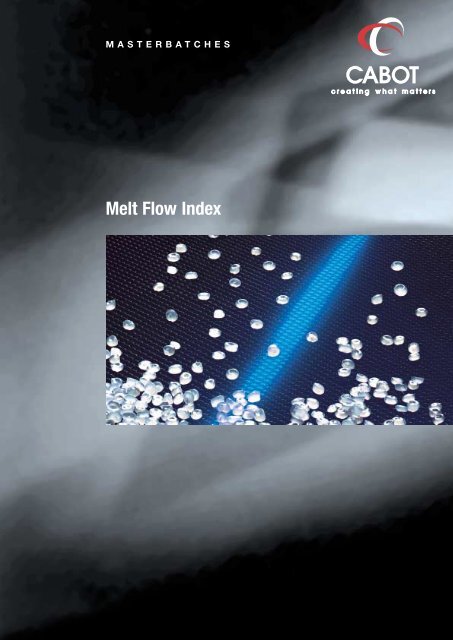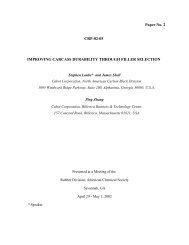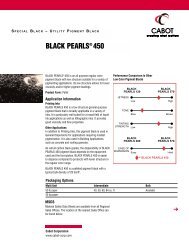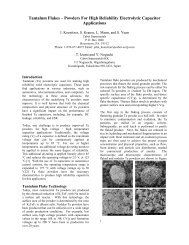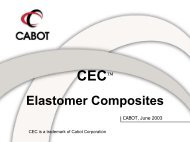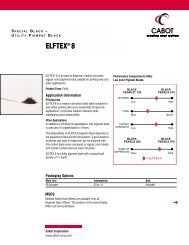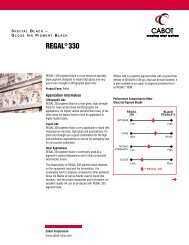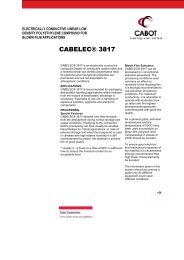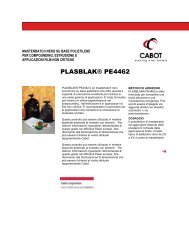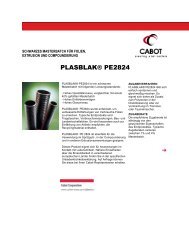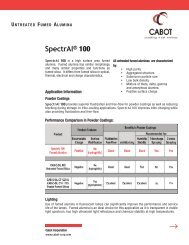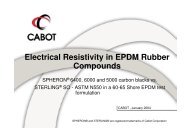Melt Flow Index - Cabot Corporation
Melt Flow Index - Cabot Corporation
Melt Flow Index - Cabot Corporation
You also want an ePaper? Increase the reach of your titles
YUMPU automatically turns print PDFs into web optimized ePapers that Google loves.
MASTERBATCHES<br />
<strong>Melt</strong> <strong>Flow</strong> <strong>Index</strong>
<strong>Melt</strong> <strong>Flow</strong> <strong>Index</strong><br />
One of the properties most often quoted for both natural polymers<br />
and masterbatches is <strong>Melt</strong> <strong>Flow</strong> <strong>Index</strong> (MFI).<br />
What is MFI and why is it significant ?<br />
<strong>Melt</strong> <strong>Flow</strong> <strong>Index</strong> is the output rate (flow) in grammes that occurs in<br />
10 minutes through a standard die of 2.0955 ± 0.0051 mm diameter<br />
and 8.000 ± 0.025mm in length when a fixed pressure is applied to<br />
the melt via a piston and a load of total mass of 2.16 kg at a<br />
temperature of 190°C (some polymers are measured at a higher<br />
temperature, some use different weights and some even different<br />
orifice sizes).<br />
<strong>Melt</strong> <strong>Flow</strong> <strong>Index</strong> is an assessment of average molecular mass and<br />
is an inverse measure of the melt viscosity; in other words, the higher<br />
a MFI, the more polymer flows under test conditions. Knowing the<br />
MFI of a polymer is vital to anticipating and controlling its<br />
processing. Generally, higher MFI polymers are used in injection<br />
moulding, and lower MFI polymers are used with blow moulding or<br />
extrusion processes.<br />
What affects the melt flow properties of polymers ?<br />
Many factors affect polymers' flow properties. Molecular weight<br />
distribution, the presence of co-monomers, the degree of chain<br />
branching and crystallinity influence a polymer's MFI as well as<br />
heat transfer in polymer processing.<br />
How is MFI important to masterbatches ?<br />
In addition to its importance to natural polymers, the MFI of a<br />
masterbatch is also important because the MFI indicates the<br />
relative ease with which a masterbatch can be distributed during<br />
a compounding operation or in injection moulding machines,<br />
film extruders, etc.<br />
2
Though all fillers and additives influence the flow<br />
properties of masterbatches, which ones have the<br />
greatest effect ?<br />
Carbon blacks have the most pronounced effect, and unless very<br />
high flow polymers are used as carriers, resultant masterbatches<br />
have little or no flow when measured using a standard 2.16 kg<br />
weight. For this reason most data sheets quote values measured<br />
using higher weights (e.g. 21.6 kg). For example, a typical masterbatch<br />
containing 40% carbon black in LDPE could have the following<br />
flow rates all measured at 190°C:<br />
Test weight (kg)<br />
MFI (g/10 min.)<br />
21.6 150<br />
2.16 < 1<br />
The main parameters of carbon blacks that influence the MFI are<br />
the particle size, structure and surface chemistry. <strong>Melt</strong> viscosity<br />
of polymer carbon black mixtures increases as the carbon<br />
black content increases and also the particle size of the black<br />
decreases. Narrow carbon black particle size distribution also<br />
leads to higher viscosity; this reinforcing characteristic of carbon<br />
blacks limits the practical levels at which they can be incorporated<br />
into thermoplastic polymers. Although there are some exceptions,<br />
50% is widely accepted as the upper limit for 60 nanometre particle<br />
size carbon blacks incorporation with resin and 40% for<br />
20 nanometre blacks.<br />
Effects of particle size on flow over a range of carbon black<br />
loadings is shown, as an example, in the following graph:<br />
<strong>Flow</strong> Properties of Masterbatches of Carbon<br />
Black in <strong>Melt</strong> <strong>Index</strong> 2.0 Low Density Polyethylene<br />
100.0<br />
50.0<br />
MFI<br />
g/10 min<br />
(190°C - 10 kg)<br />
20 NANOMETRE BLACK<br />
60 NANOMETRE BLACK<br />
10.0<br />
5.0<br />
1.0<br />
0.5<br />
0.1<br />
0.05<br />
0.01<br />
% Carbon Black<br />
16 20 24 28 32 36 40 44 48
How does someone choose a masterbatch for a specific<br />
use ?<br />
The ideal choice of a masterbatch for a specific end use is one that<br />
matches the MFI of the masterbatch as closely as possible with the<br />
MFI of the base resin.<br />
This is reasonably easy to do with titanium dioxide-based (white)<br />
masterbatches and some additive masterbatches, but not as simple<br />
with black masterbatch because of the reinforcing nature described<br />
above.<br />
If the masterbatch is to be compounded into the base polymer<br />
using, for example, high shear mixing equipment, an internal mixer<br />
or twin screw extruder, it is possible to choose a fairly low MFI<br />
carrier resin and still achieve excellent incorporation. Polymer<br />
producers generally follow this practice when making pipe or cable<br />
compounds in order not to affect the final performance properties<br />
of the compound.<br />
If poor distribution occurs when simultaneously feeding masterbatch<br />
and resin into an injection moulding or extrusion process where<br />
the shear forces are somewhat lower, the processor can adjust<br />
equipment operation conditions (such as increased back pressure,<br />
use of turbine mixing heads, or cavity transfer mixers at the end of<br />
the extruder screw). To maintain output rates, usually the processor<br />
specifies a masterbatch that is compatible with the base resin and<br />
the operating conditions.<br />
If necessary, adjustments to increase the MFI of black masterbatches<br />
are possible.<br />
Three suggestions are to use:<br />
• a higher flow carrier resin;<br />
• a less reinforcing grade of carbon black; or<br />
• process aids (e.g. stearates).<br />
If none of these are acceptable, then reducing the carbon black<br />
content in the masterbatch may be the only answer (for example<br />
use a 25% or 30% masterbatch instead of a 40% or 50%).<br />
When combinations of masterbatches are used, the high flow<br />
nature of one can adversely affect the proper incorporation of the<br />
other. In the manufacture of tackified silage film, for instance, some<br />
manufacturers add a PIB masterbatch (PIB = polyisobutylene) and<br />
black masterbatch simultaneoulsy. If distribution problems occur<br />
because the PIB reduces the shear in the system, the black<br />
masterbatch must be respecified.<br />
4
Titanium dioxide-based masterbatches (white), inert filler masterbatches,<br />
and additive masterbatches (for example, UV stabilisers)<br />
affect processing differently than carbon black masterbatches.<br />
Because materials like titanium dioxide and calcium carbonate do<br />
not have a significant reinforcing effect on resins, meaningful MFI<br />
values using a 2.16 kg weight can be measured, and much closer<br />
matching of masterbatch and base resin in MFI is possible even<br />
with loadings as high as 80%. Take, for example, a 75% titanium<br />
dioxide pigment masterbatch incorporating an LDPE carrier of melt<br />
index 20 gr/10 min. This masterbatch would have a melt index<br />
somewhere around 4 gr/10 min (2.16 Kg/190°C), which is similar to<br />
a melt index of 2 gr/10 min.(LDPE film grade commonly used by<br />
processors). Thus, the masterbatch and dilutent polymers melt<br />
indices are broadly equivalent.<br />
Many of the additives used in additive masterbatches are low<br />
melting point materials (UV stabilisers, slip agents such as oleamides<br />
or erucamides, or antistatic agents) and can melt before the carrier<br />
resin causing difficulties for the masterbatch producer and<br />
significantly increasing the effective MFI of the masterbatch.<br />
MFI is vital knowledge for polymer processing. If you want to find<br />
out more about MFI, you can refer to the following references:<br />
• ASTM Standard D1238 "Standard Test Method for <strong>Flow</strong> Ratios<br />
of Thermoplastics by Extrusion Plastometer"<br />
• ISO1133 "Plastics - Determination of the <strong>Melt</strong> Mass-<strong>Flow</strong> Rate<br />
(MFR) and <strong>Melt</strong> Volume-<strong>Flow</strong> Rate (MVR) of Thermoplastics".<br />
In addition, your <strong>Cabot</strong> representative can assist you with<br />
recommendations of <strong>Cabot</strong> masterbatches to meet your<br />
requirements.<br />
5
MFI/07.03/E<br />
<strong>Cabot</strong> (headquarters)<br />
Interleuvenlaan 5<br />
B - 3001 Leuven<br />
BELGIUM<br />
Tel.: (32) 016.39.24.00<br />
Fax: (32) 016.39.24.44<br />
<strong>Cabot</strong> Latin America Division (sales office)<br />
Av. Joao Castaldi 88<br />
04517-900 Sao Paulo, SP<br />
BRAZIL<br />
Tel.: (55) 11.5091 8300<br />
Fax: (55) 11.5542 6037<br />
<strong>Cabot</strong> Plastics Belgium S.A. (plant & sales office)<br />
Rue Prevochamps 78<br />
B - 4860 Pepinster<br />
BELGIUM<br />
Tel.: (32) 087.39.27.11<br />
Fax: (32) 087.46.98.69<br />
<strong>Cabot</strong> Plastics Deutschland (sales office)<br />
Tel.: (0800) 182 40 86<br />
Fax: (0800) 182 40 87<br />
<strong>Cabot</strong> Plastics Ltd (plant and sales office)<br />
Gate Street<br />
Dukinfield SK16 4RU<br />
ENGLAND<br />
Tel.: (44) 161.934 4500<br />
Fax: (44) 161.934 4501<br />
<strong>Cabot</strong> Plastics Hong Kong Ltd (plant & sales office)<br />
18 Dai Kwai Street<br />
Tai Po Industrial Estate/Tai Po (NT)<br />
HONG KONG SAR<br />
PRC<br />
Tel.: (852) - 2666-2666<br />
Fax: (852) - 2666-0807<br />
<strong>Cabot</strong> Shanghai Liaison Office<br />
Rm 606-617, Shanghai Central Plaza<br />
381 Huai Hai Zhong Road<br />
200 020 Shanghai<br />
CHINA<br />
Tel.: (86) 21-538 20 534<br />
Fax: (86) 21-538 27 782<br />
<strong>Cabot</strong> Italiana S.p.A. (plant)<br />
Plastics Division<br />
Zona Industriale 4<br />
I - 38055 Grigno (TN)<br />
ITALIA<br />
Tel.: (39) 0461. 775 211<br />
Fax: (39) 0461.765.146<br />
Notice and Disclaimer. The data and conclusions contained herein are based on work believed to be reliable;<br />
however, <strong>Cabot</strong> cannot and does not guarantee that similar results and/or conclusions will be obtained by others.<br />
This information is provided as a convenience and for informational purposes only. No guarantee or warranty as<br />
to this information, or any product to which it relates, is given or implied. CABOT DISCLAIMS ALL WARRANTIES<br />
EXPRESS OR IMPLIED, INCLUDING MERCHANTABILITY OR FITNESS FOR A PARTICULAR PURPOSE AS TO<br />
(i) SUCH INFORMATION, (ii) ANY PRODUCT OR (iii) INTELLECTUAL PROPERTY INFRINGEMENT. In no event is<br />
<strong>Cabot</strong> responsible for, and <strong>Cabot</strong> does not accept and hereby disclaims liability for, any damages whatsoever in<br />
connection with the use of or reliance on this information or any product to which it relates.<br />
(c) <strong>Cabot</strong> <strong>Corporation</strong>, M.A., U.S.A. All rights reserved.<br />
http://www.cabot-corp.com/plastics<br />
PLASBLAK ® , PLASWITE ® , PLASADD ® , PLASGREY ® and<br />
RAINBOW ® are registered trademarks of <strong>Cabot</strong> <strong>Corporation</strong>.


